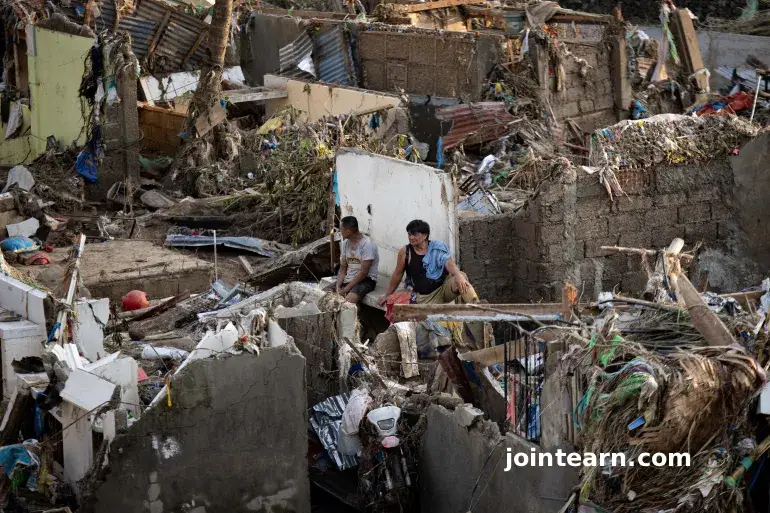
The Philippines is on high alert as Typhoon Fung-wong approaches, following the devastating impact of Typhoon Kalmaegi, which claimed over 204 lives in the Philippines and killed at least five people in Vietnam. Both nations are grappling with widespread destruction, flooding, and power outages affecting millions, while authorities warn that Fung-wong could be even more destructive.
Devastation from Typhoon Kalmaegi
Typhoon Kalmaegi tore through Southeast Asia, flattening homes, uprooting trees, and cutting power to millions. In the province of Cebu, families gathered at mass burial sites, mourning those lost to floods and landslides. One survivor, Jimmy Abatayo, who lost his wife and nine relatives, described the tragedy:
“I told my family to swim, be brave, and keep swimming. They did not hear what I said because I would never see them again.”
In the Philippines, over half a million people were displaced, with nearly 450,000 seeking shelter in evacuation centers or with relatives. Rescue crews continue searching for more than 100 missing individuals.
In Vietnam, five people were confirmed dead and three remain missing. The storm destroyed or damaged 2,600 homes and cut electricity to over 1.6 million households. Streets in Quy Nhon were littered with debris, from metal roofs to furniture, while shopkeepers tried to salvage soaked goods.
Typhoon Fung-wong: A New Threat
Authorities warn that Typhoon Fung-wong could blanket almost the entire Philippines, potentially strengthening into a super typhoon before landfall. A government meteorologist noted:
“Its radius is so wide it could cover almost the whole Philippines.”
Emergency shelters have been prepared nationwide, and residents in coastal and low-lying areas have been urged to evacuate due to the high risk of flooding and landslides. President Ferdinand Marcos Jr. has declared a state of national emergency, emphasizing that rainfall volumes have overwhelmed flood defenses, forcing some residents to seek refuge on rooftops.
Climate Crisis and Intensifying Storms
The Philippines and Vietnam are among the world’s most disaster-prone nations, regularly hit by typhoons. Experts warn that climate change is contributing to stronger and more frequent storms.
Atmospheric sciences professor Kristen Corbosiero from the University at Albany said Kalmaegi was already the fourth-strongest typhoon of the season. She added:
“The warm waters that fuel these storms are there almost year-round, and rising sea temperatures are intensifying their destructive power.”
Evacuations and Preparedness
In Vietnam, over 537,000 people were evacuated prior to Kalmaegi’s landfall, as the storm dumped up to 600mm (24 inches) of rain before weakening into a tropical storm and moving into Cambodia.
Authorities in the Philippines have ramped up mass evacuations, suspended rescue operations temporarily, and prepared emergency shelters nationwide to mitigate the impact of Fung-wong.
Looking Ahead
As Southeast Asia braces for yet another potentially catastrophic typhoon, communities are facing unprecedented challenges in disaster management and recovery. Experts emphasize that climate adaptation strategies, improved infrastructure, and early warning systems will be critical in reducing loss of life and property as storms grow more frequent and severe.


Leave a Reply